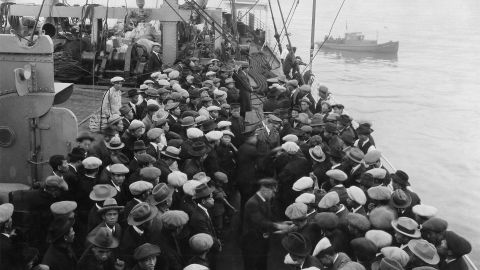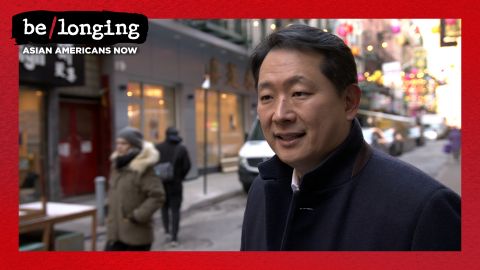CHRISTIANE AMANPOUR, HOST: In the United States, attacks against Asian-Americans are on the rise. Many are thinking back to the 1980s and the gruesome killing of Vincent Chin in Detroit. Helen Zia was on the front lines as an activist then and she still leads the fight today. She’s joining Hari Sreenivasan to discuss Chin’s story, and the challenges facing her community.
(BEGIN VIDEO CLIP)
HARI SREENIVASAN, CORRESPONDENT: Christiane, thanks. Helen Zia, thanks so much for joining us. For those who don’t remember what the story was, it just passed the 40th anniversary of the murder of Vincent Chin. And there was a documentary the PBS also played. But if people have missed that, if you could just bring us up to speed. What happened?
HELEN ZIA, AUTHOR, “LAST BOAT OUT OF SHANGHAI”: It’s incredible to think that 40 years ago there was another time of intense anti-Asian hate, even though back then it was directed towards Japan. And there was a young Chinese-American man, 27-year-old Vincent Chin, who was out celebrating his all-American bachelor party. And two white autoworkers looked at him as he celebrated and said, it’s because of you mother effs that were out of work. And then proceeded to stalk him through the city and eventually found him, and beat him to death with a baseball bat. And that would have been terrible enough. But when it finally came down to sentencing, they received probation for killing an Asian-American. And that triggered an Asian-American civil rights movement because it was as though we were reliving the 1800′ all over again. When you could kill an Asian and get off scot-free for $1. And so, that not only launched a civil rights movement for Asian-Americans but also was really a very broad-based movement that had solidarity with people from all walks of life. Asian, black, Arab-American, brown, every religion that was present in Detroit.
SREENIVASAN: What happened to Vincent Chin, happened in an era pre-hate crime laws. I think a lot of this generation, or at least people growing up today, take for granted that there was a time, in the not-so-distant past, where there was no protection from anything such as a hate crime.
ZIA: There were, in fact, liberal constitutional law professors who said, you know, Asian-Americans were not in America when these civil rights laws were created. Therefore, if the Asian-American people, including other immigrants, should not be protected by federal law. And that was something that our fledgling Asian-American community, as well as our civil rights allies, had to fight. We really had to argue that, no. This was something that Vincent Chin would have been alive today. He’d be 67 years old today had he not had an Asian face. And so, fortunately, the federal government listened to our, you know, arguments and undertook a federal civil rights investigation. Had we not won, it would have taken a very narrow view of the law. And we would not have the 2010 hate crimes law that President Obama signed into law. So, that was something that was hard-fought. And the contribution that Asian- Americans made to all Americans.
SREENIVASAN: Put us in context for what was happening in Detroit 40 years ago. And I also want to bring up to our audience, that at one point, you worked on a car plant. I mean, you worked on the manufacturing line. So, what was that culture? And what was the problem with Vincent Chin, or his Japanese counterpart, so to speak, with these autoworkers?
ZIA: Detroit is a — was a one-industry town. It was all about cars. Just to give some context, back in the 1980s, minimum wage was about $1.50 an hour. That’s what I would’ve gotten as a college graduate. When I got a job at a stamping plant, a unionized UAW stamping plant, I got almost $10 an hour and every benefit you could imagine. And so, it was an industry where people wanted those jobs. These were secure, high-paid jobs that could get you, not only your own home, but a summer home, a car, another car, an RV. And what happened in the 19 — late 1970s, after an oil crisis and gas prices, that we’re facing today, the auto industry collapsed. People couldn’t afford to buy American cars anymore. They got seven or eight to nine miles a gallon. Gas prices went from 40 cents a gallon to $4 a gallon, that would be as so today. Gas went to $6 a gallon. And so, people lost their jobs. They lost these incredibly secure — once secure jobs. People who had worked for 30 years, and what happened was an entire region, not just the City of Detroit, but everything connected to manufacturing collapsed. And that was the industrial Midwest. People were out of work and it looked like they’d be out of work for an indefinite period of time. And what that meant was in a time of intense suffering of the American people, folks were susceptible to the idea of blaming somebody. Who is causing my misery? Who is taking food from the table of my children and the future of my grandchildren? And so, that was the time. And initially, the automakers blamed the workers. The unions blamed the auto companies. People blamed the government for taking away benefits. And somehow, there was an alchemy that came together to say, let’s blame Japan. Japan is the cause of the collapse of the auto industry because they produced fuel-efficient cars. You know, Germany, actually pioneered fuel- efficient cars. And many people were buying German cars but it wasn’t declaring Germany, and people who look German to be the enemy of America. Instead, it was Japan and anyone who looked Japanese. And unfortunately for Vincent Chin, that’s what he encountered that night when he was celebrating his bachelor party.
SREENIVASAN: So now, let’s fast forward 40 years. We also have climbing gas prices. We have inflation on the rise. And oh, by the way, we’ve also had a pandemic for the past two years that has — that started in China, whether that was intentional or not is controversial to some people. But ultimately, we see a similar scapegoating.
ZIA: Asians in America have been scapegoated from the very beginning of when people of Asian ancestry set foot on this continent. And it’s something that we can trace from the early 1800s throughout the 1800s, 1900s, World War II, the war in Vietnam, the 1980s when Vincent Chin was killed. There is a master narrative in America that says, who is really American? And for people whose ancestry is from Asia, the idea is that we are the perpetual foreign invader who our intent to come to America to steal jobs, to set up shop in a neighborhood and steal the neighborhoods’ money, to take intellectual property, to destroy America. And that’s been a theme, whether it’s in the movies, whether it’s in the halls of Congress, or in video games. And so, unfortunately, it has been a threat. And so, here we are at another time when, yes, it’s a time of rising gas prices, two and a half years into a pandemic, everybody knows somebody who’s been harmed or hurt from this pandemic. Yes, there is been very bigoted finger-pointing blaming China. And because of that, everybody who — not only looks Chinese, but even just reminds people of Asia. I mean, there are so many people who have been attacked who are not East Asian, South Asian, Southeast Asian, Latinx people, who happen to remind people of — that they might be Asian have been attacked. The thing about it is that hate violence doesn’t restrict itself to one group. Yes, Asian-Americans are being targeted. This pandemic has really triggered a terrible time for Asian-Americans. But we also see a rise in hate violence toward pretty much every group. You know, whether it’s antisemitism or transphobia, or, you know, what we’ve seen and Buffalo or El Paso. And hate is a toxin. And so, this is a — this is an issue for all society, it’s not just an Asian-American problem. This is an American issue.
SREENIVASAN: I’ve got to wonder, I don’t know if it’s even a fair question. But are things better or worse than the climate that you found yourself in 40 years ago arguing on the — on behalf of the rights of Vincent Chin? I mean, did you imagine that 40 years later you and I might be having a conversation with such a similar atmosphere?
ZIA: 40 years ago, we would have had no idea that we’d be reliving something. A cycle that is, unfortunately, renewing itself. There is a difference though. And that is that back in the 1980s, there were far fewer Asian-Americans. There’s more than 24 million Asian-Americans. There are larger numbers in the halls of Congress who are speaking up for our communities. And as well as reaching out to other communities. And so, there is a light, I guess, we can say. In terms of the hate that we’re experiencing, I think there’s a general consensus that this is worse than the 1980s. You know, on top of an economic crisis that we’re only at the beginning of. We don’t know when this is going to end. We don’t know when the pandemic, that’s on top of it, that’s global, is going to be, you know, something that we can look in the rearview mirror. We just don’t know that. And so, you know, with the mass killings that we’ve been seeing with the constant hate every day. Something in the headlines people don’t know whether they can send their children off to school or even go to work themselves. And so, there is a feeling that this is worse. And the, you know, the idea that back in 1982, Vincent Chin could be killed as though he were an animal, being beaten to death with a baseball bat. While in New York City, we see an elderly woman who was being stomped on more than 100 times on her head as though she is an insect. And so, there is a clear dehumanization process going on. And with U.S.- China relations not really showing any sign of improving in the near term, you know, the view that China is the existential threat to America. We hear that all the time, too. That does not bode well for Asians in America.
SREENIVASAN: One of the things that I remember from the film, just also — just reading about Vincent Chin is that, if there was a silver lining is that it did galvanize a movement into being. That it did unify, in many ways, so many different types of Asian-Americans but also other people, as you mentioned. And I wonder, are there events now that have the same impact? I mean, last year, when the attacks happened on the spot in Atlanta, Georgia, it seemed like an unthinkable crime. But at the very beginning, and sort of one of the first press conferences, you know, you remember the police officers say, I don’t think race was an issue. I mean, it was so quickly dismissed until the, sort of, the people dug in deeper. But you see that response so often that I wonder if there is that galvanizing effect for people saying, hey, this is actually happening today and racism is a factor here.
ZIA: Well, there is a galvanizing effect. I think that it will take time. One of the things that’s happened also in these 40 years has been the really pervasive efforts to drive wedges, to separate people, to say one group is better than another, one group is worse than another. And for Asian-Americans, that’s been this view that Asian-Americans do not experience racism. That there is no discrimination against Asians because of — we are virtually white. We are the — this racist view of being a, “Model Minority”. And that is a — meaning, we are the good minority which pits us against people who are presumed to be the bad minority. And that’s been incredibly corrosive, divisive thing that was not invented by Asian-Americans, by the way. It has a time and a place, 1966 was when this first emerged by a white sociologist as a theory. And that has become so ingrained that that police officer in Atlanta, the very first thing he said was, oh, it has nothing to do with race. Asians don’t experience racism. This has been said over and over and over again in other mass killings, of the first schoolyard shooting that was in 1989. A school in Stockton, California of mostly Southeast Asian refugee children. You know, fiver, eight-year-olds were shot to death then. And the first thing the police officer said, the chief was — this has nothing to do with race. Well, there was an outcry that then led to an investigation, finding that the killer actually had white supremacist ties. But that is, kind of, the knee- jerk reaction when something happens to Asian-American. Even with this pandemic. When there were, you know, videos that went viral, people said, oh, I didn’t know Asian-Americans could experience discrimination. Well, in fact, that’s a sign of the ignorance that we have. The things that are missing in history. Which is why it’s so important that Illinois and New Jersey legislatures have mandated that some kind of Asian- American curriculum should be taught K through 12. Because this lack of understanding is really a problem. And unfortunately, we have more than 11,000 accounts, you know, in the last two and a half years to show that, actually, it is a problem.
SREENIVASAN: I ask, in part, because when you survey Americans, about a third of them don’t feel like there are any increased acts of racism or violence towards Asian-Americans. And I also wonder how much of that is our own communities, at least first-generation immigrants are taught to just focus on your education. Don’t get in trouble. Don’t get political, right? I mean, because I’m trying to figure out, how is this reality so separate from the perception of the reality?
ZIA: You know, for immigrants, and I’m the daughter of immigrants, too. My parents didn’t know anything about what it meant to be Asian in America, or Chinese in America. They were too busy trying to just survive and adapt to an entirely different culture. And also, they felt like they were guests in America. So, they were not inclined to try to figure out how their children might be more integrated in American society as American voices in a democracy. And so, the idea that if you keep your head down, you know, you’ll encounter less problems. That was something we faced as an issue that people raised during the organizing around Vincent Chin. People said, if we speak up, will we risk more trouble? And we had to say, if we don’t speak up, these things will happen all the time. And so, that is really, you know, a mind shift that it takes for an immigrant group. And that, I think, is the time we are in now. If we just hide out, things will, you know, clear up eventually. That is also being part of the problem. Because we’re seeing that it doesn’t matter whether you’re an investment banker on your way to work in New York, you could be pushing in front of a subway train. And I think that is waking up a lot of people, too. And I think for other Americans it’s seeing, well, OK. Today is an AK-47 aimed at Asian-Americans but that can be turned against anybody, in any schoolyard. And so, I think there is a broader recognition that there’s something deeper here. And for Asian-Americans, that’s certainly something that we need to actually think about, talk about, talk about with our children, and our elders. Why is this happening? And to really see that in a democracy, it’s true, those who speak up more get hurt. And if you’re silent, and you don’t speak up, you know, you — you’re under the bus.
SREENIVASAN: Helen Zia, thanks so much.
ZIA: Well, thank you.



